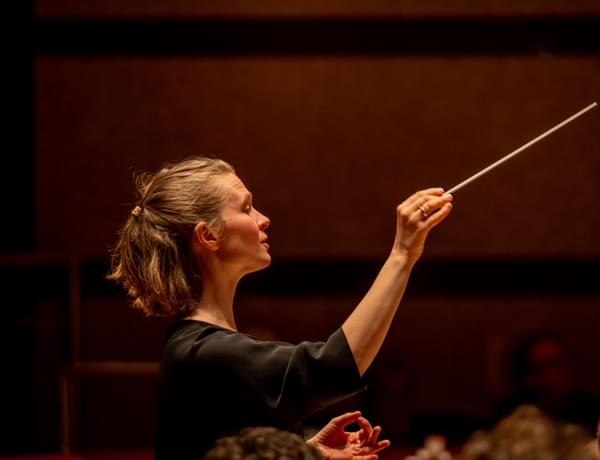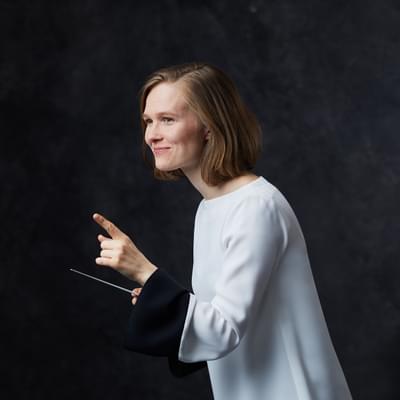Mirga conducts Weinberg & Brahms

Full programme
- Brahms, Violin Concerto (38mins)
- Weinberg, Symphony No.5 (46mins)
Performers

Mirga Gražinytė-Tyla
ConductorStephen Waarts
Violin
Introduction
This week we could not be more excited to welcome back our former Music Director Mirga Gražinyte-Tyla. She led the CBSO artistically from 2016 to 2022, creating an extremely varied and bold musical vision. It is always a joy to welcome back our previous Music Directors and fantastic that as her life journeys on, Mirga continues to celebrate the CBSO, our musicians and our city. Welcome back Mirga!
For those of you who may not have seen MIrga conduct before, you are in for a treat. She has always delighted audiences with her “balletic” style of movement - you can see through her gestures how she shapes the music and how the orchestra respond to her. She is a singer as well as a conductor and perhaps because of this you can feel the long lines and lyrical quality in her music making.
In this visit, like many other recent visits, Mirga is once again championing the work of the Polish, Soviet composer and pianist, Mieczysław Weinberg (1919 - 1996). A contemporary and great friend of Shostakovich, Weinberg suffered the effects of war and oppression, and his music still awaits the recognition and regular performance it merits within the concert hall. Piece by piece Mirga is gradually bringing his work back to life and to audiences across the world.
An exclusive Deutsche Grammophon artist since 2018, Mirga’s first album featuring Weinberg’s Symphony No.21 with the CBSO was released in the spring of 2019 and went on to win both the Opus Klassik and Gramophone Awards later in 2020. Today we will hear his Symphony No.5, which is also being recorded live for release by Deutsche Grammaphon.
Before Weinberg, Stephen Waarts will perform the Brahms Violin Concerto. Winner of the 2014 Yehudi Menuhin International Competition, Stephen is making his CBSO and Symphony Hall debuts tonight.
As everyone at the CBSO celebrates Mirga’s return this week, everything feels extremely joyful and familiar. We very much hope you enjoy the concert as much as we will.
Catherine Arlidge MBE
Director of Artistic Planning
Programme notes
A welcome return for CBSO's Associate Artist Mirga Gražinytė-Tyla to lead the CBSO in Brahms’ gorgeous, sweeping Violin Concerto (the composer apparently sweated over every bar, but you would never know it!), tackled by Stephen Waarts. Weinberg’s Fifth Symphony is a powerful musical journey through grief and sorrow, rejecting triumph in an unresolved sense of struggle.
Violin Concerto in D, Op.77
Johannes Brahms (1833-1897)
The history of Brahms’ Violin Concerto is a tale of a particular person and a particular place. "I only wanted to stay there for a day” wrote Brahms to Clara Schumann, in May 1878. “But the first day was so beautiful that now I intend to stay for quite a while”. “There” was the lakeside resort of Pörtschach in Austrian Carinthia. “I’m continuing to bathe in the warm lake-water” he told another friend” “and in the warmth of the Austrians – called Gemutlichkeit”. It’s impossible to miss that warmth in the Violin Concerto he wrote there. And for Brahms, in the 1870s, a work for violin could be meant for only one man – the Hungarian virtuoso Joseph Joachim. The whole concerto is as much a homage to Joachim’s friendship as to the Carinthian scenery.
From the very start of the concerto - its warm, swinging opening subject introducing a string of successively lovelier themes, none a million miles from a waltz – the music unfolds at an expansive pace. The violin’s dramatic, minor-key opening flourish, meanwhile, marks out the other extreme of the concerto’s expressive world. The genius of this first movement is the way it satisfies the demands of virtuoso display, and of a stormy symphonic development, without making the solo part sound anything other than a spontaneous, expressive improvisation. In the traditional place, just before the coda, Brahms left Joachim space to improvise his own cadenza – and then brings the orchestra back in with a stroke of pure, hushed magic.
Brahms feared that his Adagio might sound too slight after so broad an opening movement; but its opening - in which the violin spins a Bach-like aria over a transfigured wind serenade in the manner of Mozart – could scarcely make a better foil. Measured, inward and quiet, the poignant evening colours of its closing bars give no hint of what is to come in the Finale. Classical precedent goes by the board, as the solo violin launches a brilliant gypsy-rondo – an affectionate, folk-fiddle tribute to Joachim’s Hungarian roots. With its swaggering themes and glittering runs, this is entertainment-music of the most open-hearted kind; and after a short, brilliant cadenza it breaks into joyous, out-and-out comedy. Brahms is serious, but never self-important. When Joachim premiered the concerto, in Leipzig on New Year’s Day 1879, Brahms was nearly late. He turned up to conduct in the nick of time – suspenders unbuttoned, shirt untucked, and wearing a creased pair of grey everyday trousers.
Symphony No.5 in F minor, Op.76
Mieczysław Weinberg (1919-1996)
Mieczysław Weinberg went by many different names. In Warsaw between the wars, he grew up as Mojsze Wajnberg, the son of a Yiddish-speaking theatre musician in the city’s large and lively Jewish community. In 1939 he graduated from the Warsaw Conservatoire, and fled the Nazi invasion in the only direction that seemed possible - to the USSR. And here he acquired another name, in an incident that he recalled years later:
On 17th September, Soviet forces entered the war, came to Western Ukraine, and we happened to be on the new border…We implored the Soviet soldiers to let us pass through. I didn’t sopeak Russian then, but I managed to get a lieutenant, He said, “OK, Weinberg, what is your name?” I said “Mieczysław” – “Jews do not have a name like this”. I said, “Why?”. “You will be ‘Moisey’”. I said, “Fine, Moisey, Abram, whatever you want, just let me into the Soviet Union!
As Moisey Vainberg, he lived and worked in Russia for the rest of his life – his roots eradicated by the Nazis, who murdered his entire immediate family. Nor was the USSR a safe haven. In 1953, Weinberg himself was arrested and imprisoned on charges of “Jewish bourgeois nationalism”. Imprisoned in the Lubyanka, the massive KGB torture-house in central Moscow, he faced death or the gulag. In the event, he was suddenly and unexpectedly released.
Whether his release was due to the sudden death of Stalin, or a letter interceding on his behalf from Dmitri Shostakovich, remains unclear, but Weinberg’s friendship with Shostakovich was lifelong. Weinberg described himself as Shostakovich’s “pupil, his flesh and blood”. They’d met in Moscow in October 1943, when Weinberg played through his First Symphony for the older composer, and their rapport seems to have been immediate. It was certainly enduring, and their friendship – as well as Weinberg’s profound admiration for Shostakovich’s music – found many echoes in Weinberg’s own work. For his own part, Shostakovich, considered Weinberg “one of the outstanding composers of our time”.
In the case of the Fifth Symphony – which was first performed on 18th October 1962 by the Moscow Symphony Orchestra – there’s a particular synergy at work. It’s a substantial achievement on its own terms: epic in scale, cast in the four movements of a classical symphony and set in F minor: a key that Beethoven connected with turbulence, darkness, and passionate struggle (but also, conversely, the key of the young Shostakovich’s brilliant and sardonic First Symphony, now four decades into a happier past).
But Weinberg was intensely aware that Shostakovich’s Fourth Symphony – suppressed by the composer in 1936 after Stalin’s bloodcurdling threats against his opera Lady Macbeth – had finally received its official premiere in December 1961. This was the era of Khrushchev’s “thaw”, but for years, Weinberg had been one of the very few people who actually knew the work: Shostakovich had played through the symphony with him at the piano (in private, of course – anything else was too dangerous). There’s a kinship of tone between Shostakovich’s Fourth and Weinberg’s Fifth; in its tragic scale, its massive climaxes and its flashes of black humour.
But you don’t need to know that to grasp Weinberg’s Fifth Symphony. Weinberg was his own man, a different (perhaps more quiet) but equally striking personality, and in the Fifth Symphony he speaks at full power. The first movement begins with quiet cries and mutterings against a backdrop of eerie, wavering uncertainty, and gradually starts to sing – and then (with whirling, almost savage force), to dance. The song continues in the second movement: the strings’ whispered uncertainty has now opened out and light is beginning to spread across this melancholy landscape. The oboe starts to ask questions that might once have gone unasked as the movement climbs slowly towards a passionate climax, before inching very quietly offstage.
The third movement begins with military pipe and drums - part playful, part ominous; suddenly terrifying and then mocking, with a black humour that Weinberg would have been the first to describe as Jewish. A celeste glimmers weirdly (like a willow-the-wisp) over the closing bars, and a clarinet leads into the gently-rocking opening of the finale. There’s terror in this movement, as well as a passionate sadness leavened by glints of wit, of playfulness and even joy, and the ending is anything but a triumph. But it’s no less satisfying for that. Some questions do not have easy answers, other than a quiet, knowing joke and a resolve (however cautious) to push on. Weinberg saw his survival as a gift. and his music always allowed at least a glint of hope in the darkness. “It is impossible to repay the debt” he told his second wife. “No amount of creative work would ever take me even an inch closer towards paying it off”.
© Richard Bratby